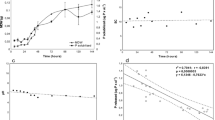Abstract
Colonization of Hordeum vulgare L. cv. Salome (barley)and Triticum aestivum L. cv. Caprimus (wheat) roots by the arbuscular mycorrhizal fungus Glomus intraradices Schenck & Smith leads to de novo synthesis of isoprenoid cyclohexenone derivatives with blumenin [9-O-(2′-O-β-glucuronosyl)-β-glucopyranoside of 6-(3-hydroxybutyl)-1,1,5-trimethyl-4-cyclohexen-3-one] as the major constituent and to transient accumulation of hydroxycinnamate amides (4-coumaroylagmatine and -putrescine). Accumulation of these compounds in mycorrhizal wheat roots started 2 weeks after sowing together with the onset of arbuscule formation and proceeded with mycorrhizal progression. Highest levels were reached in 3- to 4-week-old secondary roots (root branches of first and higher order) characterized by the formation of vesicles. In the final developmental stages, the fungus produced massive amounts of spores, enclosing the stele of older root parts (older than 5 weeks) characterized by cortical death. In these root parts, the secondary compounds were detected in trace amounts only, indicating that they were located in the cortical tissues. Some rhizosphere bacteria tested, i.e. Agrobacterium rhizogenes, Pseudomonas fluorescens, and Rhizobium leguminosarum, markedly stimulated both fungal root colonization and blumenin accumulation, thus, acting as mycorrhiza-helper bacteria (MHB). Application of blumenin itself strongly inhibited fungal colonization and arbuscule formation at early stages of mycorrhiza development. This was associated with a markedly reduced accumulation of the hydroxycinnamate amides 4-coumaroylputrescine and -agmatine. The results suggest that both the isoprenoid and the phenylpropanoid metabolism are closely linked to the developmental stage and the extent of fungal colonization. Their possible involvement in the regulation of mycorrhiza development is discussed.
Similar content being viewed by others
Author information
Authors and Affiliations
Additional information
Accepted: 18 September 1998
Rights and permissions
About this article
Cite this article
Fester, T., Maier, W. & Strack, D. Accumulation of secondary compounds in barley and wheat roots in response to inoculation with an arbuscular mycorrhizal fungus and co-inoculation with rhizosphere bacteria. Mycorrhiza 8, 241–246 (1999). https://doi.org/10.1007/s005720050240
Issue Date:
DOI: https://doi.org/10.1007/s005720050240




